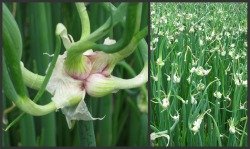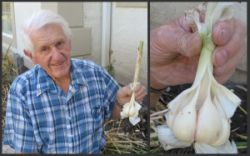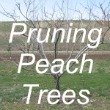|
Growing RaspberriesWe love growing raspberries. Raspberries do well in cooler climates. It takes a while to establish productive raspberry plants. Once they get established they produce for many years. There are two types of raspberries: a June Bearer and an Ever bearer. The June Bearers start producing fruit early in the summer. They produce fruit on last year’s growth. Pruning these raspberries take more time than the Ever Bearer. 
The Ever Bearers produce fruit on this year’s growth. These raspberry plants produce fruit later in the summer. Easy to Prune! For a detailed explanation on these two types of raspberries see
Pruning Raspberries.
Soil PreparationGrowing raspberries need rich, loamy, well-drained soil. Soil preparation is very important when planting raspberries. Because raspberries are perennials, it’s harder to improve the quality of the soil from one year to another. This is why we recommend giving your raspberry patch a healthy head start by adding the following soil conditioners. It really helps to transform your clay soil into light, loamy, garden soil. For each 25 foot row of planting add:
Rototill these into the soil. Once the raspberry plants are established, you can add organic matter to top of the soil each Fall. But you can’t rototill these additions into the soil. With that said, we still recommend that you add organic matter to your raspberry patch each year. As leaves, grass, manure, and other organic material decompose, the fertility and texture of the soil improves. See
Types of Soil.
Back to Top Planting RaspberriesThe raspberry rootstock should be planted in the early spring. This allows the roots to establish themselves before the weather gets hot. Plant the raspberries about 18-24 inches apart in the row. The rows should be planted about 6 feet apart. Evenly spread out the roots of the raspberry plants. The roots should not be covered with more than 1 ½ inches of soil. This is a very important step to implement. I’ve tried planting raspberry starts deeper than this, and the young plants don’t survive. Keep the young growing raspberries well watered for the first month. Then keep them moist the rest of the summer. Don’t over water. See
Garden Watering Systems. Back to Top 
Creating New Raspberry PlantsAs the roots start to spread, the raspberries will send up new shoots between the rows. Dig up these shoots to create new raspberry plants. Expand your patch or share these new raspberry shoots. If you don’t want to create new plants, you still need to remove the new shoots between the rows. Otherwise, the growing raspberries will overrun your patch. There won’t be any place to walk. Back to Top Building a Raspberry Trellis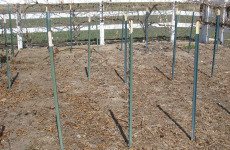
Build a trellis for your raspberries. Trellising your growing raspberries helps support the canes and keeps the fruit off the ground. You can build a simple trellis using green steel posts. But any kind of post will work. Put a row of post down each side of the raspberry plants. The raspberry plants will grow down the middle of this three-foot trellised area. The next three-foot spacing will be your walkway. In the next three-foot spacing you’ll plant your next row of raspberry plants, etc. 
Set your posts every 8 – 10 feet. See Diagram. String a row of twine 1 ½ feet off the ground and a second row of twine 3 feet off the ground. The growing raspberries lean on the twine as they get tall. Back to Top Harvesting Raspberries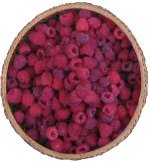
It takes time for the roots of the raspberry plants to get established. You’ll get some berries the first year but not many. A larger crop will be produced the second year. As the berries develop and mature, only pick the ones that are red. While the raspberries are in season, they need to be picked about 2 times a week. The season last about 2 months. When the frost comes, you can cut the Ever Bearers off at the ground. If you have June Bearing raspberries, you can cut out all the canes that bore fruit this year. See
Pruning Raspberries.
Back to Top Harmful Insects and Diseases
If you have a healthy raspberry plant that withers and dies within a couple days, it probably has cane borer. Promptly remove the infected canes from the garden. Burn them or put them in the garbage can. The chance of raspberries getting cane borer is reduced when you cut off all the Ever Bearing canes each fall. This is one reason we prefer the Ever Bearers. If your plants are going to struggle with cholorosis, it will happen during the spring and early summer. The absorption of iron is essential in creating new foliage. Also, if you over water the raspberry plants, they have a hard time absorbing the iron in the soil. They will get yellow. Keep them moist but not soaking wet. Back to Top Return to Growing Fruit from Growing Raspberries |






